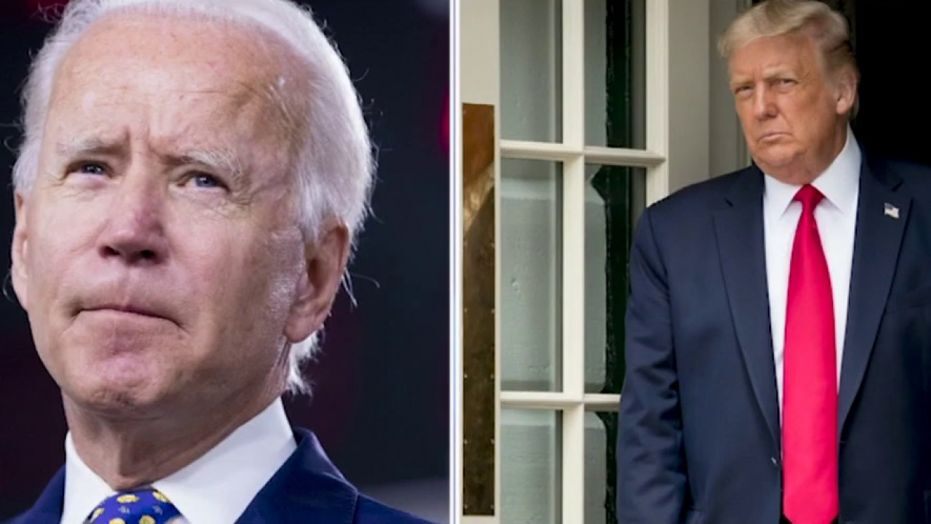It’s hard to keep up with national politics these days — no less what’s happening in your state and local governments. Now, try to think back to everything that’s happened in state politics since 2009.
It was a major political decade in Minnesota, and believe it or not, some of the stories here rival the intrigue coming out of Washington, D.C., every day.
From the longest government shutdown in state history to the rise and fall of some of the state’s most prominent politicians, here are the top stories in state politics between 2009 and 2019, listed in somewhat chronological order:
Unallotment

Then-Gov. Tim Pawlenty discussed the Minnesota Supreme Court’s ruling regarding the unallotment case in May 2010.
Jeffrey Thompson | MPR News 2010
Back in the summer of 2009, after lawmakers went home for the year, former Republican Gov. Tim Pawlenty wielded a little-known executive power to unilaterally cut or shift $2.7 billion from the state budget.
Democrats who controlled the House and Senate were furious, arguing Pawlenty used the power to cut spending out of the budget they sent him because he didn’t want to sign a tax bill they also sent him to pay for it. The Supreme Court ultimately ruled his use of unallotment was improper, with Pawlenty’s former law partner and Supreme Court pick Eric Magnuson authoring the deciding opinion against him.
Republicans sweep the Legislature

Then-Republican Senate Majority Leader Amy Koch spoke to reporters at a news conference in June 2011.
Tom Scheck | MPR News 2011
The tea party wave in 2010 helped deliver a majority to Republicans in the state House and Senate for the first time since the modern day state Republican Party was designated back in the 1970s.
It gave them the power to shape state policy and budgets for the first time in decades, but there was a big caveat: The first Democratic governor in decades, Mark Dayton, was also elected that year and would repeatedly clash with their agenda.
Longest shutdown in state history

The grounds of the Minnesota State Capitol in St. Paul remained quiet in July 2011 as the state government shutdown continued.
Nikki Tundel | MPR News 2011
One of Dayton and the Republican-controlled Legislature’s biggest disagreements was over the state’s two-year budget in 2011 and how to close a multibillion-dollar budget deficit.
They couldn’t agree to a deal by the end of session in May or by June 30, the end of the fiscal year and the constitutional deadline to pass a balanced budget. State government shut down the next day and stayed shut down for 20 days, easily the longest government shutdown in state history.
Rise — and fall — of Amy Koch

Republican state Sen. Amy Koch resigned as majority leader in 2011 after revelations of an affair with a subordinate.
Jeffrey Thompson | MPR News 2011
The tea party wave also brought a rising star lawmaker into the spotlight. Then-Republican Sen. Amy Koch orchestrated her party’s takeover of the chamber and was elected Senate majority leader for her efforts — the first woman in state history to ever hold that position.
But one year later, Koch’s political rise came to an abrupt halt when four male colleagues held a press conference — without her — to reveal she had an affair with a subordinate. She resigned as majority leader the next day and didn’t seek reelection the next cycle.
Her subordinate, Michael Brodkorb, was fired by the Senate, kicking off a wrongful termination lawsuit in which he argued he was treated differently than female staffers who had relationships with male elected officials. He threatened to bring those relationships to light, but never did, eventually settling with the Senate for $30,000.
The Vikings stadium

Minnesota Vikings owner Zygi Wilf spoke at a news conference after Minneapolis was selected as the host for 2018 Super Bowl at the NFL’s spring meetings in May 2014 in Atlanta.
David Goldman | AP 2014
It was hard to believe the Republican-led Legislature and Dayton could agree on anything, no less a $1 billion new stadium for the Minnesota Vikings that required hundreds of millions of dollars in public subsidy. But they struck a deal in 2012, ending a more than decadelong saga to get the stadium built.
It was a session full of twists and turns, from the defeat of the stadium bill in a key House committee to its unlikely revival in the final days of session.
Photo ID and gay marriage amendments rejected

Demonstrators on both sides of the issue gathered outside the Minnesota House chamber to greet lawmakers as they arrived to take up the same-sex marriage bill at the State Capitol in May 2013.
Jim Mone | AP Photo 2013
While Dayton vetoed many Republican priorities, they were able to bypass him and put two proposed constitutional amendments on the 2012 ballot: a photo ID requirement to vote and a ban on gay marriage (it was already banned in state law).
Democrats launched massive campaigns to defeat the amendments, which voters ultimately did. It was no easy feat: Polling leading all the way up to Election Day showed both amendments had enough support to pass.
The 2012 election also swept Democrats into control of the Legislature and all of state government. By May, they’d flipped the debate from constitutionally banning gay marriage to a successful push to make Minnesota the 12th state in the nation to allow same-sex couples to marry.
The troubled MN ‘somethings’

Then-MNsure Chair Brian Beutner, left, listened as interim CEO Scott Leitz spoke during a press conference in December 2013 in Minneapolis. Leitz took over after the resignation of April Todd-Malmlov, who faced criticism over complications with insurance sign-ups under the federal health care law.
Glen Stubbe | The Star Tribune via AP 2013
MNsure, MNLARS? Those two government-run IT projects consumed much of the Capitol’s limited oxygen supply for the better part of the last decade, with technical glitches, cost overruns and long delays for Minnesotans either trying to buy health insurance or update their vehicle tabs and registration.
The MNsure insurance exchange is running more smoothly now, and MNLARS has now been scrapped for VTRS — Vehicle Title and Registration System — which lawmakers hope won’t have the same problems when it’s rolled out.
Minnesota Capitol restoration

Master stone carver Mark Wickstrom selected a tool while working on exterior restoration at the State Capitol in St. Paul in April 2015.
Jeffrey Thompson | MPR News 2015
It started more than a dozen years ago as a $100,000 study to explore the restoration needs on the inside of the Minnesota Capitol. But it ballooned into a $310 million project to revive dulled murals, fix plaster work, install massive slabs of marble to fix the crumbling exterior and rewire the entire structure to make it a modern workspace.
It took years and shut down most of the building during that time, but the idea was to restore the more than 100-year-old building for the next 100 years to come.
Sunday liquor sales

In 2017, Minnesota lawmakers scrapped a ban on Sunday liquor sales.
George Dornbach | MPR News 2017
It only took 159 years, but in 2017, Minnesota lawmakers scrapped a ban on selling alcohol on Sundays. Before that, the Sunday liquor sales debate was a perennial issue at the Capitol, making strange bedfellows of Republicans and Democrats who routinely defeated it over religious objections and opposition from liquor stores, who liked not being open on Sundays.
Legislature’s budget vetoed

Education Minnesota President Denise Specht joined other groups urging Dayton budget vetoes in May 2017.
Brian Bakst | MPR News 2017
After another messy end to the 2017 legislative session, Dayton zeroed out the Legislature’s $130 million operating budget at the same time he signed the rest of the state’s two-year budget.
It was a final attempt to get lawmakers to renegotiate some tax breaks and teacher licensure provisions they disagreed on, but the Legislature didn’t bite. Instead, they sued the governor arguing he violated the Constitution’s separation of powers between the Legislative and executive branches. A lower court agreed, but the Minnesota Supreme Court ultimately upheld Dayton’s veto.
#MeToo comes to Minnesota

Sen. Al Franken, center, held hands with his wife, Franni Bryson, as he left the Capitol after speaking on the Senate floor in December 2017 in Washington. Franken announced his resignation following a wave of sexual misconduct allegations and a collapse of support from his Democratic colleagues.
Jacquelyn Martin | AP 2017
Allegations of sexual harassment and assault were sweeping up prominent people in the media and politics across the country in 2017, and by late fall, two state legislators resigned amid allegations of repeated inappropriate behavior toward women in politics.
Their stories revealed a broader culture of sexual harassment in workplaces, including the state and national capitols. In Washington, D.C., Minnesota U.S. Sen. Al Franken was also facing a string of allegations of unwanted groping and forcible kissing. After pressure from his Senate colleagues, he resigned from office in December 2017.
Lieutenant governor dominoes

Then-Republican gubernatorial candidates Hennepin County Commissioner Jeff Johnson, left, and former Minnesota Gov. Tim Pawlenty at MPR News in August 2018.
Evan Frost | MPR News 2018
Franken’s resignation in the middle of his term set off a stunning series of events. It triggered a law that allowed Dayton to appoint his replacement — Lt. Gov. Tina Smith — until the next general election, which triggered a different constitutional provision requiring the Senate president take over as lieutenant governor.
But there was one problem: The Senate president was Republican Michelle Fischbach, who wasn’t exactly thrilled about leaving the chamber to serve alongside a Democratic governor. The Senate fought back in court, but the case ultimately went unresolved.
Fischbach announced shortly after session ended that she would, in fact, take over the lieutenant governor job and leave the Senate. Why? She later became the lieutenant governor candidate alongside Pawlenty as he attempted an executive branch comeback.
Republicans struggle statewide
Minnesota Republicans took control of part or all of the Legislature for most of the last decade, and in 2018, they flipped two Greater Minnesota seats from Democrat to Republicans. But the party hasn’t won a single statewide office since 2006, when Pawlenty was elected to a second term as governor.
Twice, the Republican Party picked Hennepin County Commissioner Jeff Johnson as their gubernatorial candidate, only to have him lose handily twice. It’s a concerning streak for party operatives, who worry the voting power of the Twin Cities and suburban communities could lock them out of that office for decades to come.

